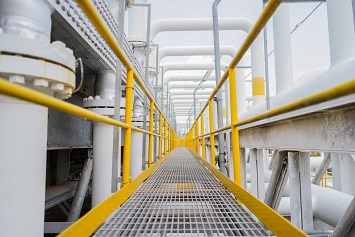In construction, unguarded openings and edges are common. Regardless of whether the hazard exists on the roof of a completed home, at the edge of an open excavation, or along the leading edge of the upper floor of an office building under construction, construction employers have an arsenal of tools available to identify and protect workers from the hazards of unguarded edges and openings. Unguarded edges and openings are less common in general industry—but are just as dangerous and just as deadly.
 |
Here are some tips for recognizing unguarded edges and openings in general industry settings and how to control this hazard.
Unguarded Edges and Openings
Unguarded edges and openings in general industry include:
- Loading docks, floors, or platforms. Loading docks are often an unrecognized fall hazard when left unguarded. Unguarded floors and platforms may also exist, for example, in areas where equipment or walls have been removed, or where platforms have been built to access elevated parts of equipment. Sometimes the walkways or platforms around open equipment are unguarded, or the openings into the equipment are below the level of a standard guardrail. Workers have fallen into process equipment with unguarded edges.
- Roof and floor edges and openings. Roofing is a construction activity, but maintenance on roof-installed structures, inspections, and similar activities fall under general industry rules. The roof access may be unguarded along one or more edges, or there may be other openings in the roof, like skylights, that pose a fall hazard. On flat roofs, there is sometimes a parapet wall that is waist-high or lower; this is lower than standard guardrail height and not adequate for fall protection purposes. Floor openings may include cellar-door or attic-stair type hatches, when they’re open. Also, openings may not necessarily be in a “floor”—for example, removing a manhole cover creates an unguarded opening at the level of the walking surface.
- Ramps, runways, and stairs. Ramps and runways are sometimes unguarded; less frequently, a staircase may be unguarded along one or more edges. Even if the fall from a ramp or runway is less than 30 inches at its highest point, it can pose a fall hazard for both people and equipment.
- Landings, balconies, and porches may be open, glazed, or (more commonly) have railings that are lower than the required height—for example, the railings at a stadium or ballpark are often only 34 inches high, to avoid obstructing a spectator’s view, and the press boxes sometimes have only a low parapet wall, which does not provide adequate fall protection. Glazed openings, also, may not be designed to prevent people from falling through these openings.
- The tops of railcars and trailers. Workers may climb onto flatbed trailers or railcars, tankers, or other rolling stock that is unguarded, exposing them to fall hazards of 2 to 14 feet.
Fall Prevention Strategies
In construction, fall protection often includes personal fall arrest systems, but in general industry, these are less common. More commonly, fall protection in general industry involves the installation of standard guardrails along open edges. Standard guardrails are 42 inches tall, with a midrail at 21 inches, often with a 4-inch footboard to prevent falling-object hazards.
On loading docks, guardrails may be used, or the dock may be equipped with a roll-up door that is kept closed when no trailer is at the dock.
Personal fall arrest systems that include overhead tracks for tying off are available for the protection of employees who work on top of rolling stock of all types. These systems can be either permanently installed or mobile.
